Assessment of key drivers of deforestation and understanding the local community's perception of its impacts in the case of Shabe Sombo District, Jimma Zone, South West Ethiopia
Автор: Kebede W.G.
Журнал: Овощи России @vegetables
Рубрика: Общее земледелие, растениеводство
Статья в выпуске: 2 (82), 2025 года.
Бесплатный доступ
Relevance. Deforestation is a major environmental challenge that has persisted over time and worsened in recent years. It is a primary concern for developing countries, including Ethiopia, due to its negative effects, such as biodiversity loss and increased greenhouse gas emissions. This study investigates the key drivers of deforestation and community perceptions of its impact in the Shabe Sombo district, Jimma zone, southwest Ethiopia. Data Collection. Primary data were gathered through questionnaires from 187 household heads selected simple random sampling. Additionally, interviews and focus group discussions (FGDs) were conducted with purposively selected individuals. Study Areas. Four kebeles; Atiro Gefare, Mirgano Baso, Yanga Dogoma, and Sombo Daru were purposively selected from the Shabe Sombo district. Data Analysis. Both qualitative and quantitative methods were employed. Quantitative analysis was performed using SPSS to evaluate questionnaire responses, while qualitative content analysis was used to interpret interview and FGD data. The findings were expressed through descriptive statistics such as percentages, frequencies, tables, and charts.
Deforestation, direct and indirect cause, key drivers and community perception
Короткий адрес: https://sciup.org/140309937
IDR: 140309937 | УДК: 635.64:631.527.56 | DOI: 10.18619/2072-9146-2025-2-103-112
Текст научной статьи Assessment of key drivers of deforestation and understanding the local community's perception of its impacts in the case of Shabe Sombo District, Jimma Zone, South West Ethiopia
Оригинальная статья / Original article
orests and agriculture are essential parts of farming systems where farmers rely on them for their livelihoods [1]. The role of forests in providing livelihoods and alleviating poverty has gained increased attention over the past few decades. For rural communities, forest resources are a primary means of livelihood, supporting livestock farming, providing agricultural inputs, and supplying timber and non-timber forest products [2]. Forests are often seen as a free resource, available for conversion to other uses without considering the impact on their environmental services.
Deforestation is defined by the [3] as the direct, human-induced conversion of forested land to non-forested land. Forest degradation, on the other hand, occurs when the ecosystem functions of the forest are impaired, but the area remains forested [4]. Deforestation is a widespread environmental issue that significantly affects the resilience and distribution of forests. It typically results from clearing forests for agriculture and other land uses [5]. In various African countries, forests provide essential goods such as timber and non-timber products (e.g., bamboo, chew sticks, game) that support the rural economy [6].
Deforestation is particularly concerning for developing countries, including Ethiopia, due to its adverse effects like biodiversity loss and increased greenhouse gas emissions [7]. Deforestation occurs for several reasons: trees and charcoal can be sold as commodities, and cleared land can be used for pasture, farming, plantations, and human settlements [8]. Forest degradation impacts livelihoods and income generation activities by reducing and eliminating direct economic services [9].
Ethiopia, rich in natural resources, is currently facing intense pressure and challenges due to population growth, weak economic development, destructive usage practices, recurrent droug ht, and resource mismanag ement. Deforestation and forest degradation are significant hurdles to Ethiopia's sustainable socio-economic development, manifesting in land degradation, water resource depletion climate change, prolonged dry seasons, biodiversity loss and decreased agricultural productivity [10].
Ethiopia's forest resources are diverse, ranging from lowland scrubs to tropical rainforests [11]. Beyond environmental benefits, these forests contribute economically and socio-culturally by creating jobs, generating income, diversifying livelihoods, combating poverty and food insecurity, and providing energy [12]. Forests are also vital for timber production and tourism development [13] and for producing traditional medicines for humans and livestock, especially in rural areas. However, in recent decades, rapid population growth, increased crop cultivation in marginal areas, intensified livestock grazing, soil erosion, and poor agricultural practices have led to severe forest degradation [14; 15; 13].
T he extensive deforestation and other factors have caused significant soil degradation and nutrient depletion, sharply reducing agricultural productivity in Ethiopia. Soil erosion due to deforestation is a critical environmental issue, with Ethiopia losing fertile topsoil at an estimated rate of one billion cubic meters per year [14], severely affecting agricultural productivity . Other negative consequences of deforestation in Ethiopia include biodiversity loss, climate change, devastating floods, high runoff, and wood shortages [12;16]. Various economic, demographic, and socio-political factors contribute to forest resource degradation in Ethiopia. This study aims to explore the socioeconomic and environmental impacts of deforestation and community perceptions of these impacts in the study areas.
MATERIALS AND METHODS
Description of the study area
Location of the study area
The study was conducted in the Shabe Sombo district, Jimma Zone, southwest Ethiopia. Geographically, it is located between 7˚17'-7˚44' North latitude and 36˚17'-36˚52' East longitude in the Jimma Zone. The district is situated along the Jimma-Bonga main road, 50 km from Jimma town. It shares borders with Seka
Chokorsa to the north and northeast, the Kefa Zone in the south and southeast, and Gera District to the west and southwest. It is positioned in the southern part of the Jimma Zone [17].
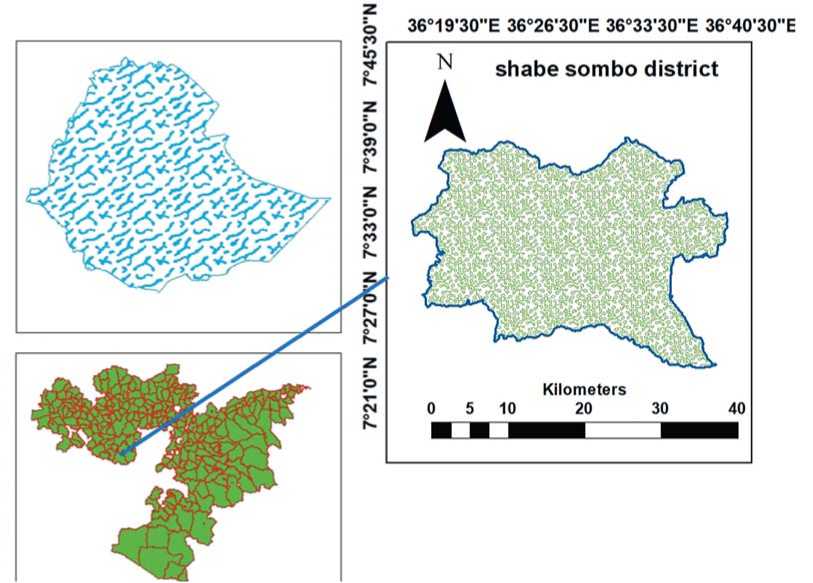
shabe sombo district
Kilometers
'30"E
36°19'30"E 36°26'30"E 36°33’30"E 36°40
Figure 1. Map of the study area Soil
The soil pattern in Shabe Sombo clearly illustrates the relationship between climate, geological structure, and vegetation cover. The main soil types in the area include some of the best agricultural soils: red-brown soils (35%), black soils (45%), and grey arid brown soils with a heavy texture (20%). These soils generally have good agricultural potential, with the exception of sandy soil. Additionally, loam and sandy soils are present in the District and can be used as raw materials for construction [17].
Climate and drainage
The total area of the District falls within the Gojeb River catchment of the Gibe River Basin. Major perennial rivers such as the Gojeb, Anja, Gurati, and the smaller Anja Rivers flow into the Gibe River. These rivers are primarily used for traditional irrigation and washing red coffee. The Districts does not have any lakes.
Regarding climate, most of the District is characterized by subtropical (Badda Daree) and cool (Baddaa) agro-climates, which make up 40% and 60% of the District area, respectively. The western part of the District experiences a cool agro-climate with a mean annual temperature ranging between 17-20°C. In contrast, the western part has a subtropical climate with a mean annual temperature ranging from 20-23°C.
The rainfall pattern in the District is weakly bi-modal, with a small rainy season in spring during April and May, and a more significant rainy season in summer from June to August. Annual rainfall in the District varies between 1,400 mm and 1,900 mm [17].
Vegetation covers
The district is well-endowed with natural forest coverage, encompassing approximately 35,000 hectares, while man-made forests cover about 10,000 hectares. Of the total natural forest area, around 25,597.94 hectares are managed under a Participatory Forest Management (PFM) approach (Takahashi and Todo, 2011). This management strategy is active in 14 kebeles within the District where 44 forest management associations operate under the Belete-Gera Regional Forest Priority Area. These associations are responsible for managing the 25,597.94 hectares of forest in the District [17].
The forest is characterized by a rich biodiversity, with dominant tree species including Syzygium guineense, Olea wel-witschii, Prunus africana, and Pouteria adolfi-friederici. This forest is noted for its significant biodiversity, making it crucial for both conservation efforts and socioeconomic benefits [18].
Population
According to CSA [19], the total projected population of the District is 141,037, consisting of 71,150 males and 69,887 females. Of this population, 132,935 individuals reside in rural areas, while 8,102 live in urban centers. In terms of age distribution, there are 70,776 adults aged between 15 and 64 years, 43,565 children aged 0 to 14 years, and 24,988 elderly individuals aged 65 and above. The District has a notably high proportion of adults, with the majority of the population falling within the 15-64 age range.
MethodsTypes and sources of data
Both primary and secondary data sources were utilized for the study. Primary data were collected through key informant interviews, household questionnaires, focus group discussions (FGDs), and direct observation. Secondary data were obtained from various literatures accessed via the internet, as well as from district and small Administration unit offices. The primary data focused on identifying the key drivers of deforestation and understanding community perceptions regarding deforestation.
Sampling Techniques and Sample Size
A cross-sectional survey design incorporating both qualitative and quantitative methods was employed for this study. Shabe Sombo district was purposefully selected as the study area due to its prevalent issues of agricultural expansion, illegal logging, and resettlement. Four small Administration unit; Atiro Gefare, Mirgano Baso, Yanga Dogoma, and Sombo Daru were randomly selected from the district, in consultation with local natural resource management experts. A proportional sample of 187 households was then determined using Israel's [20] formula, with households selected proportionally from each small Administration units.
n = N ------------ N-------------- equ (1)
1+ N(e2)
Where: - n = the sample size N = the population size e = is the level of precision (±7%).
n = ----1---+----2---1---7---6---(--0---.-0---7---)--2
= 187
Table 1. Sampling size per kebeles
No small Administration unit Household No_ Sample size proportion
1 Atiro Gefare 54046
2 Mirgano Daso 56749
3 Yanga Dogoma 49943
4 Sombo Daru 57049
Table 1. Sampling size per kebeles
|
No |
small Administration unit |
Household No_ |
Sample size proportion |
|
1 |
Atiro Gefare |
540 |
46 |
|
2 |
Mirgano Daso |
567 |
49 |
|
3 |
Yanga Dogoma |
499 |
43 |
|
4 |
Sombo Daru |
570 |
49 |
Method of Data Collection
To gather both quantitative and qualitative data, a combination of questionnaires, focus group discussions, and non-participant observation was employed. Structured questionnaires were developed and pretested to align with the study objectives, while focus group discussions, structured interviews, and nonparticipant observation were used for qualitative data collection Before data collection commenced, enumerators received comprehensive training on study objectives, questionnaire completion, respondent interaction, and data collection methods Suitable times and locations for key informant interviews and focus group discussions were arranged in collaboration with kebeles administrators.
Household Survey questionnaire
Household survey questionnaire provides structured numerical data. Socioeconomic information were collected from all the total sample size 187 households. During preparing and collecting the questionnaire, much emphasis was given to the household demographic characteristics, household socio-economic characteristics, issues related to deforestation, effects of defor- estation on socioeconomic and environmental effects, and possible recommendation. In order to get a reliable data from respondents both close ended quantitative data and open ended qualitative data questionnaires are prepared and administered to the target households.
Field Observation
Observation served as a critical tool for gathering firsthand information throughout the study. Non-participant observations were conducted to examine cultivated and uncultivated lands, topography, vegetation cover, settlement patterns, and the overall extent of deforestation. By immersing themselves in the study area, researchers collected detailed field notes and photographs, providing a comprehensive understanding of the landscape. This observational approach facilitated a holistic analysis of the study findings.
Key Informant interview
Key informants for interviews were selected purposively from each small Administration unit. These informants included knowledgeable and elderly individuals who have lived in the area for over 25 years, as well as experts. The names of all households (HHs) in the kebeles were obtained from the small Administration unit office and verified with the key informants. A total of eight key informants were chosen from the four kebeles, with two informants from each small Administration unit. The selection of these key informants, who are experienced and well-informed about the area, was conducted using the snowball sampling method [21].
Focus group discussion
Discussions were held in each selected small Administration unit with groups of individuals of different genders to understand deforestation, its causes, impacts, and farmers' perceptions of its effects. Emphasis was placed on selecting farmers with extensive experience and knowledge aboutthe diversity and utilization of woody plants. The discussions focused on the causes and impacts of deforestation in the study areas. Data were collected from stakeholders through focus group discussions, which addressed deforestation issues and potential recommendations for sustainable practices. Each focus group consisted of 8 to 10 participants and lasted approximately two to three hours. The results of these discussions were analyzed in relation to the study's objectives.
Method of data analysis
The data collection and screening steps were followed in data analysis. Majority of the data collected through survey questionnaires were analyzed quantitativelythrough application of descriptive statistics by using SPSS (version, 24) software and Microsoft Excel 2010. The data collected by interview and FGDs were analyzed qualitatively with key event approach or thematic description. Family size, educational level, land holding size and income, Population growth, Agricultural land expansion, Fuel wood, Charcoal production, Urbanization and infrastructure development and logging are the socioeconomic variable. Therefore, table, chart and graph have been applied for data presentation.
RESULTS AND DISCUSSION
Socioeconomic Profile of Sampled Respondents
The results of the survey indicated a significant gender disparity among the sampled household heads, with 87.5% being maleheaded and 12.5% female-headed. Additionally, 96.88% of respondents were married, while only 3.13% were unmarried. Regarding educational attainment, the participants displayed a range of educational levels: approximately 27.08% were illiterate, 60.42% had basic reading and writing skills, and about 12.5% had received formal education. A notable proportion of respondents were between 41 and 50 years old, and the majority had a farm size of around 38.54% (see Table 2).The survey also revealed a concerning trend of neglect toward agriculture, particularly among both older and younger individuals, which poses a challenge to food security. Many rely on subsistence farming and use outdated, environmentally harmful techniques, exacerbating issues like deforestation and soil degradation. The fact that 60.42% of respondents possess only basic literacy skills highlights a potential barrier to adopting modern agricultural practices. Practices such as conservation tillage, contour plowing to prevent erosion, and intensive farming methods to combat deforestation may not be easily accessible or understandable to the surveyed population. Therefore, there is an urgent need for targeted educational initiatives to promote sustainable farming practices and address environmental concerns within the community.
Table 2. Socioeconomic Profile of Sampled Respondents
|
Variables |
Categories |
Number of respondents |
Percent (%) |
|
Male |
164 |
87.50 |
|
|
Sex |
Female |
23 |
12.50 |
|
Total |
187 |
100.00 |
|
|
Married |
181 |
96.88 |
|
|
Marital status |
Unmarried |
6 |
3.13 |
|
Total |
187 |
100.00 |
|
|
Educated |
23 |
12.50 |
|
|
Education level |
Read and write |
113 |
60.42 |
|
Illiterate |
51 |
27.08 |
|
|
Total |
187 |
100.00 |
|
|
20-30 |
16 |
8.33 |
|
|
31-40 |
60 |
32.29 |
|
|
41-50 |
70 |
37.50 |
|
|
Age |
51-60 |
25 |
13.54 |
|
61-70 |
10 |
5.21 |
|
|
>70 |
6 |
3.13 |
|
|
Total |
187 |
100.00 |
|
|
<1ha |
23 |
12.50 |
|
|
1-2.5ha |
62 |
33.33 |
|
|
Farm size in (ha) |
2.6-3.5ha |
72 |
38.54 |
|
>3.5ha |
30 |
15.625 |
|
|
Total |
187 |
100.00 |
The key drivers of deforestation in the study areas
Direct cause of deforestation
Agricultural expansion
The results highlight that agricultural expansion, particularly the cultivation of land, is a primary driver of deforestation and land use/cover changes in the study area. The majority of respondents (94.79%) identified agricultural expansion as the main threat to deforestation (see Figure for graph, 8). Land is a vital resource in Shabe Sombo Woreda, used for agricultural production, income generation, house construction, and settlement. Key informants noted that the local community heavily depends on agriculture for their livelihoods, engaging in mixed farming that includes both crop cultivation and livestock rearing.
According to a report from the Shabe Sombo District Office (2022), households generally have small land holdings ranging from 0.67 to 1.25 hectares. Due to these limited land sizes, crop yields often fall short of meeting the needs of farming households. Similar observations from various parts of Ethiopia have identified the expansion of agricultural land into forested areas as a major driver of deforestation and disruption of forest ecosystems. This finding aligns with previous studies by Bielli [22] and Dessie and Kleman [23], which emphasized agricultural encroachment as a significant factor in forest loss in Ethiopia.
Informants also noted several factors contributing to low agricultural production in the area, including inappropriate land use systems, limited awareness of modern farming practices, and the high cost of inorganic fertilizers. As a result, farmers often expand their cultivated land into forests and woodlands. Some farmers have organized at the micro level to secure additional land for cash crops such as chat and eucalyptus trees. This
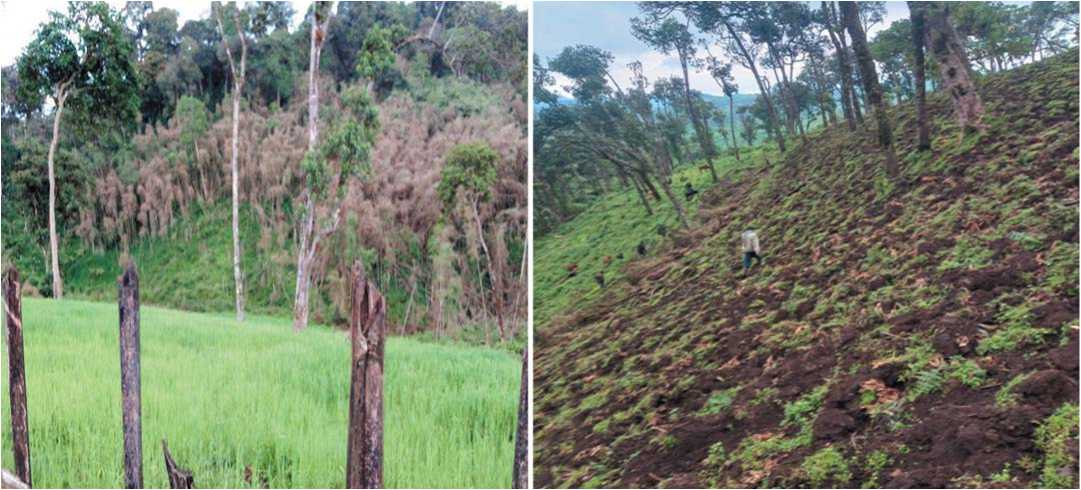
Figure 2. Agricultural expansion in the study areas
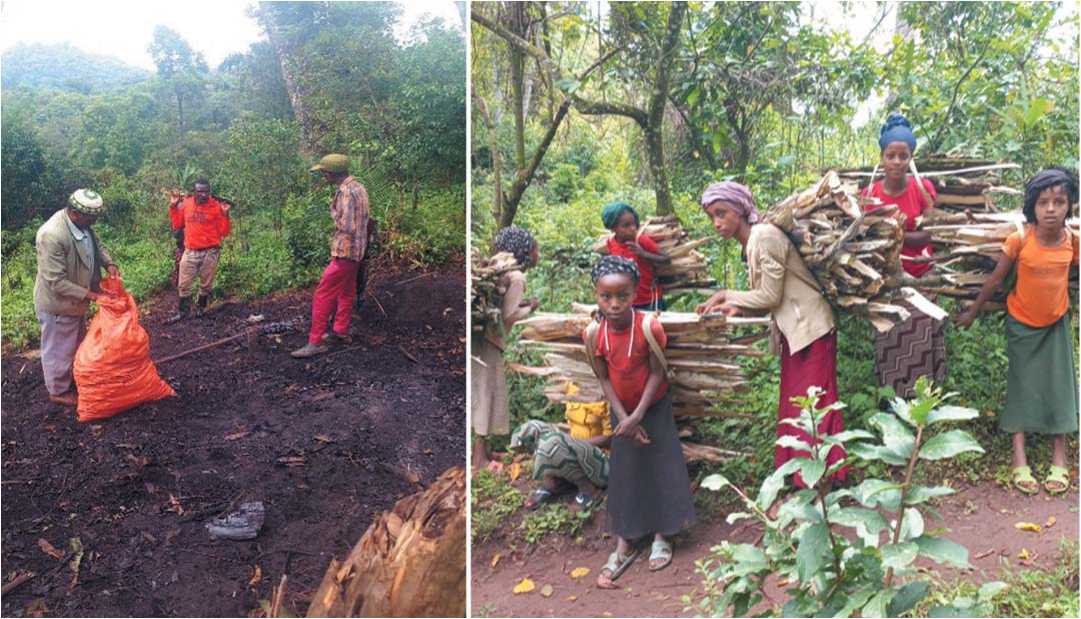
Figure 3. Fuel wood and charcoal production in the study areas
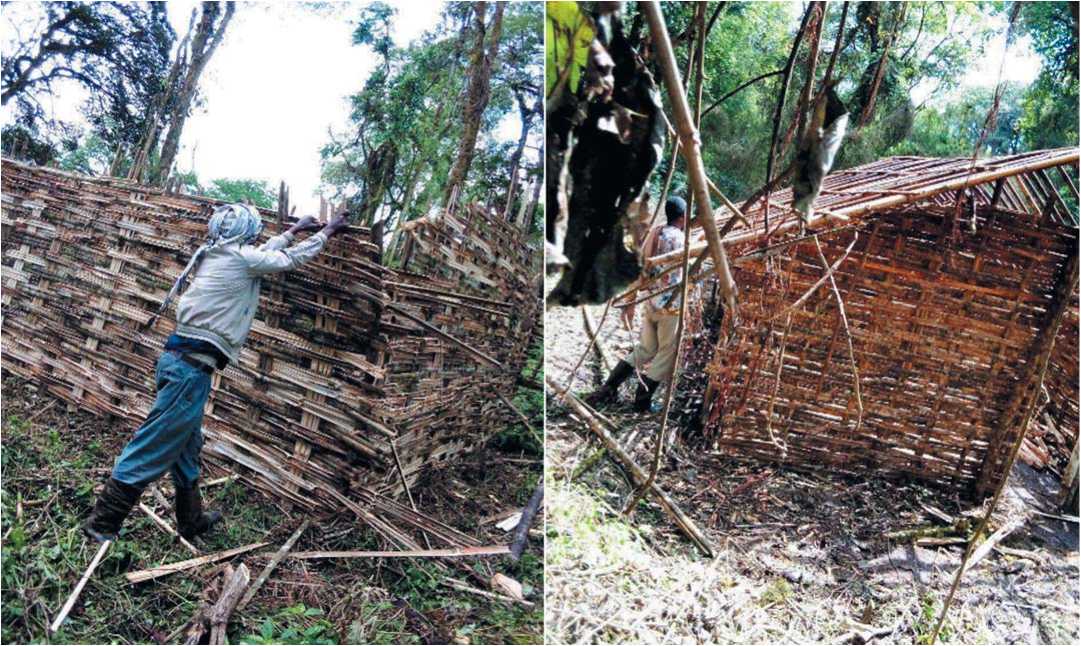
Figure 4. Settlement expansion in the study areas
ongoing encroachment into surrounding forests has led to further degradation of these areas. Farmers have observed a significant increase in cultivated land at the expense of forested areas, underscoring the severity of this issue.
Fuel wood and charcoal production
The results of the study highlight the negative impacts of fuelwood consumption on forest resources, biodiversity, and human livelihoods in the area. Approximately 85.42% of respondents identified fuelwood and charcoal production as major drivers of forest cover change (Figure, 5). The predominant use of fuelwood for cooking and lighting in the study area exceeds the national rural reliance on solid energy in Ethiopia, which is around 96% [24].
Focus group discussions revealed that charcoal production is a common practice for generating household income. Participants noted that firewood collection is a major destructive activity, as the local community heavily relies on natural forests for fuel energy for both consumption and sale. Additionally, there was significant concern about the illegal logging of forest timber products. Overall, the abuse of forest resources under the guise of fuelwood collection remains a serious issue, impacting both the community's forest-based livelihoods and environmental sustainability.
Settlement expansion
Settlement expansion is identified as a significant driver of forest conversion in the study area. About 96.88% of respondents highlighted that settlement and resettlement activities are major contributors to forest cover change (see Figure, 5). This finding is consistent with previous research indicating that the expansion of settlement areas, particularly with permanent housing, leads to a reduction in woody vegetation [25].
Key informants noted that urbanization could be beneficial as it improves the socio-economic status of people in the area.
They emphasized that urbanization facilitates infrastructure development and creates employment opportunities for local residents. One informant mentioned that many locals, including some qualified individuals, have been hired due to urbanization. While urbanization has positively affected the socio-economic conditions of many people in the study area, it has also exacerbated environmental degradation. Thus, the benefits of urbanization come with significant environmental trade-offs.
Grazing land expansion
The results reveal that a substantial proportion of respondents (62.5%) identified the expansion of grazing lands as a key driver of deforestation (Figure, 5). Livestock grazing is recognized as a major cause of deforestation, as highlighted by Tariq et al. [26]. In Ethiopia, small natural vegetation is crucial for livestock feed, with approximately 10% of fodder used during the wet season and 60% during the dry season sourced from forested areas [27].
Livestock affect forests in two significant ways: by consuming vegetation as fodder and by trampling and crushing small plants dueto the high number of cattle and herds. This overgrazing and trampling contribute to deforestation and have detrimental effects on forest ecosystems. The FAO [28] report further confirms a strong connection between deforestation and cattle ranching, emphasizing the impact of livestock on forest degradation.
Indirect cause of deforestationEconomic factors
Economic factors are also identified as significant drivers of forest cover change, with about 93% of the sampled households utilizing forests for economic purposes (see Figure, 6). This economic use of forests has contributed to a gradual reduction in forest cover. As demand for forest products increased in the market, people have been cutting and selling forest resources to
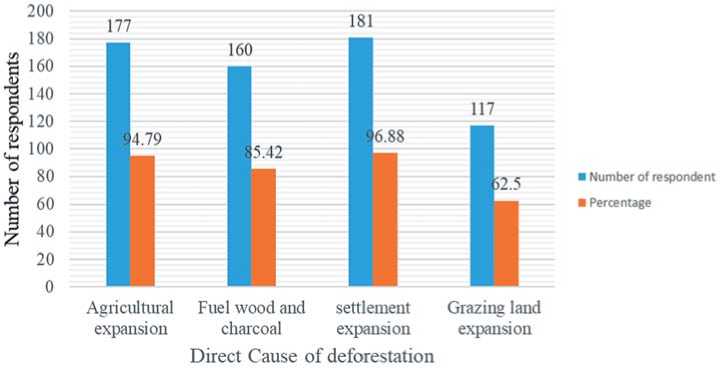
Figure 5. Direct cause of deforestation in the study areas
generate income for their livelihoods. Similarly, when crop prices rose, individuals sold forest products to purchase food for their families. These findings align with reports indicating that economic factors are major drivers of tropical deforestation [29].
Policy and institutional factors
The study identified policy and institutional factors as major contributors to forest cover and land use changes, with approximately 83.33% of respondents acknowledging these issues (see Figure, 6). Key drivers include policy failures such as corruption or mismanagement in the forestry sector and weak implementation of Participatory Forest Management (PFM). Institutional shortcomings, such as uncertain land tenure systems, which lead to lower investment and stimulate illegal logging, have been noted as significant factors in deforestation [29]. Additionally, weak policy enforcement, inadequate forest management capacities, land use conflicts, and policy discrepancies exacerbate forest losses. The implementation of investment and settlement policies without proper environmental impact assessments also poses a major issue [30]. Similarly, changes in policies governing natural resources have been shown to influence land use changes and agricultural expansion [25].
Socio-cultural factors
The study also identified social-cultural factors as significant drivers of forest cover changes inthe study area. Public attitudes such as indifference toward forests, low environmental morale, and frontier mentalities, alongside a lack of fundamental environmental values and beliefs, contribute to deforestation. Approximately 63.54% of respondents attributed forest cover changes to these social-cultural factors (Figure, 6). This indifference towards forest environments is a key factor in the ongoing changes in forest cover.
Population growth
The study highlighted population growth as a major driver of forest and land use/land cover changes in the study area. This is closely linked to anthropocentric factors influencing deforestation. Immigration, population growth, and increasing population density were identified as significant contributors to forest cover changes, with 96.88% of respondents acknowledging population growth as a key factor (Figure, 6). Previous research also supports this finding, indicating that demographic factors such as population growth and density are critical drivers of forest cover change.
Socio-economic and environmental effects of deforestation
The study reveals that a significant majority of respondents (95.83%) believe deforestation directly influences their livelihood incomes (Table 3). Deforestation affects the hydrological aspects of watersheds, altering water resources and environmental conditions locally and globally. The conversion of forests to agricultural land reduces rainwater infiltration and percolation, affecting the recharge of streams, springs, and underground water sources. Most respondents (92.7%) noted that forest
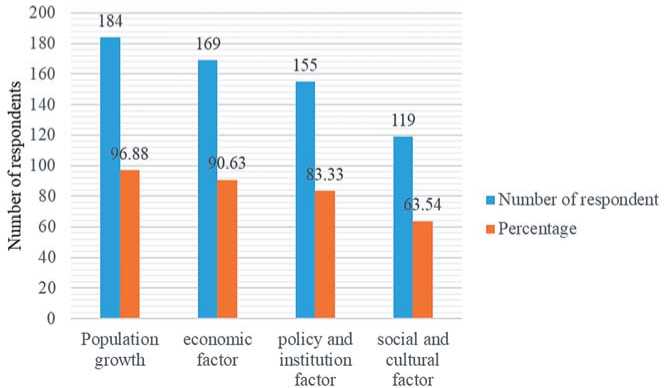
Indirect cause of deforestation
Figure 6. Indirect cause of deforestation in the study areas
ISSN 2618-7132 (Online) Овощи России №2 2025 [ 109 ] Vegetable crops of Russia №2 2025 ISSN 2072-9146 (Print)
depletion has led to a decline in surface water volume over time.
Interviews with focus groups and elders confirm that the volume and flow patterns of local streams and rivers have decreased. Additionally, 97.91% of respondents perceive that deforestation has increased local temperatures, and 90.62% observe a decrease in rainfall with the decline in forest cover (Table 3). Local farmers and elders have observed various climate changes, including the drying up of wetlands, the increase in livestock diseases potentially linked to vector-borne illnesses, a reduced growing period, and shifts in crop cultivation practices. Socio-economic impacts include longer distances to fetch water and decreased availability of drinking water for animals.
The study area, once rich in indigenous tree species like Syzygium guineense, Olea welwitschii, Prunus africana, and Pouteria adolfi-friederici, has experienced significant ecological and biodiversity loss due to deforestation driven by settlement and agricultural expansion. The increasing human population continues to pressure the remaining forests, with complex and widespread impacts on livelihoods, traditions, and forestdependent communities. The majority of respondents (93.75%) linked forest destruction to increased erosion in the district (Table 3). Soil erosion, particularly sheet erosion on cultivated lands, has exacerbated soil fertility issues. This erosion is a significant concern among local land users, highlighting the need for addressing both environmental and socio-economic impacts of deforestation.
Farmers’ perception on deforestationin shabe sombo Woreda
The study indicates that a vast majority of respondents (97.92%) recognize deforestation as a real problem in Shabe
Sombo district (Table 4). Among the respondents, 32.29% view deforestation as "the clearance of forest for different purposes," while 43.75% see it as "logging and burning of forests." Additionally, 23.96% of respondents understand deforestation as "the permanent clearing of forests for crop farming" (Table 4).
When asked about the severity of the problem, 90.62% of farm households deemed deforestation a critical issue in the study area. This perception aligns with the broader context of deforestation in Ethiopia, which has experienced significant declines in forest cover throughout the 20th century. Forest cover in Ethiopia, which was around 40% in the early 20th century, dropped to approximately 16% by the 1960s and further to about 2.5% by the end of the century. However, recent data indicate a slight improvement, with forest cover now around 9% [31]. Deforestation in Ethiopia is characterized by the indiscriminate clearance of forest and woodland resources, a critical issue in many developing countries. The extent and rate of deforestation vary by region, but the challenges faced by Shabe Sombo District reflect the broader trends observed across the country.
The Strategies identified to minimize deforestation
Focus group discussion was implemented to triangulate the responses from household interview on possible solutions of threats of deforestation in the study area. From the analysis of informants’ suggestion as possible solution of deforestation is Awareness related to Problem (97.92%) were major way to minimize the loss of plant diversity followed by reforestation (96.87%), Afforestation (90.62%), Controlling Illegal cutting (78.12%) and using alternative energy (62.5%) in the community nearby to the forest (Table 5).
Table 3. Socio-economic and environmental effects of deforestation
|
Parameter |
Agree |
Disagree |
Undecided |
|||
|
F |
% |
F |
% |
F |
% |
|
|
Affect livelihood incomes |
92 |
95.83 |
1 |
1.04 |
3 |
3.12 |
|
Decrease of the amount of surface water volume |
89 |
92.7 |
2 |
2.08 |
5 |
5.21 |
|
Increase local temperature |
94 |
97.91 |
1 |
1.04 |
1 |
1.04 |
|
Affect variability of rainfall |
87 |
90.62 |
4 |
4.16 |
5 |
5.21 |
|
High erosion prevalence |
90 |
93.75 |
4 |
4.16 |
2 |
2.08 |
|
High loss of habitat of animals and plants |
93 |
96.87 |
1 |
1.04 |
2 |
2.08 |
|
Increase of forest products price |
90 |
93.75 |
2 |
2.08 |
4 |
4.16 |
Table 4. Farmer’s perception on deforestation in shabe sombo Woreda
|
Parameter |
Response option |
frequency |
Percent |
|
Yes |
183 |
97.92 |
|
|
Do you know the impacts of deforestation in your area |
No |
4 |
2.08 |
|
Total |
187 |
100 |
|
|
Yes |
169 |
90.62 |
|
|
it is a critical problem |
No |
18 |
9.38 |
|
Total |
187 |
100 |
|
|
The clearance of forest |
61 |
32.29 |
|
|
How deforestation is perceived by the local people |
The logging and burning of forest |
82 |
43.75 |
|
The permanent clearing of forest for crop farming |
44 |
23.96 |
|
|
187 |
100 |
The promotion of alternative energy sources (like biogas and solar energy) should be encouraged to reduce dependence on the use of firewood. Reducing deforestation would also require creating and strengthening reversal of deforestation such as awareness rising on consequences of deforestation (public education) and strengthening participatory forest restoration and protected area expansion programs. This is in line with the same recommendation from Asfawa and Fikadu [32]. It is vital therefore, that the Woreda natural resource administrative body or Forest and environment office to enhances the land use planning process in addition to identifying and implementing appropriate decision to mitigate harmful effects of development activities (like illegal agricultural expansion, urbanization and settlement expansion) on forest resources. During data collection session the researcher observed that, the nearby society still, rely on the forest for their daily life activities and most people cut down trees for fuel wood and charcoal production.
The deforestation is dynamic significantly effects of livelihood incomes, Decrease of the amount of surface water volume, Increase local temperature, Affect variability of rainfall, High erosion prevalence, High loss of habitat of animals and plants Increase of forest products price in the study areas. Destruction of forest (deforestation) is also a significant problem in Ethiopia. On the other hand, deforestation in the Shabe sombo area is perceived as the clearance of forest for different purpose by 32.29% of the house hold”, logging and burning of forest, the clearance of forest for different purposes by 43.75% of the households. Again the problem (deforestation) is understood as the “the permanent clearing of forest for crop farming” by about 23.96% ofthe respondents. The possible recommendation for minimize deforestation is the critical importance for sustainability of forest. From the analysis of informants’ suggestion as possible minimize of deforestation is Awareness relatedto Problem (97.92%) were major wayto min-imizethe loss of plant diversity followed by reforestation (96.87%),
Table 5. Possible recommendation for minimize deforestation
|
Parameter |
Agree |
Disagree |
Undecided |
|||
|
Freq. |
P (%) |
Freq. |
P (%) |
Freq. |
P (%) |
|
|
Reforestation |
181 |
96.87 |
2 |
1.04 |
4 |
2.08 |
|
Afforestation |
169 |
90.62 |
4 |
2.08 |
15 |
8.33 |
|
Awareness related to Problem |
183 |
97.92 |
2 |
1.04 |
3 |
1.26 |
|
Controlling Illegal cutting |
146 |
78.12 |
21 |
11.45 |
20 |
10.42 |
|
Using Alternative source |
117 |
62.5 |
48 |
26.04 |
23 |
11.45 |
The effort to control the prevailing destruction of Ethiopia's forests and associated ecosystems and reverse the consequent social and economic disruptions is not adequate when compared to the attention that the problem requires. Nevertheless, countrywide tree planting activities, afforestation campaigns, and the demarcation of forest resource areas have been undertaken. The development of a participatory management system, in which local communities play an important role through joint forest management, and the participation of the private sector in the forestry sector are crucial steps. Improving the institutional frameworks of forestry for effective management, integrating forestry into all land uses so that trees become an integral part of land use practices, enhancing the efficiency of forest use, and carrying out updates of data on the resources, among others, may contribute to the improvement of forest resources, the environment, and the people.
CONCLUSION AND RECOMMENDATIONS


